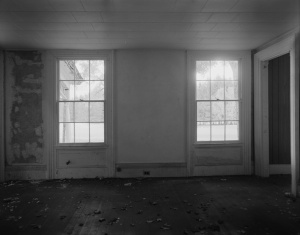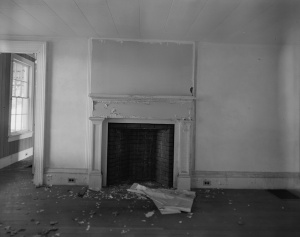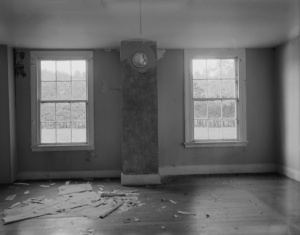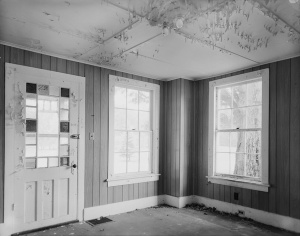The house by the woods
by J. Robert Lennon
“A writer with enough electricity to light up a country.” Ann Patchett
It is a few minutes past one in the morning when the front door slams shut. Anyone remaining in the house – but there is no one – would be able to hear, through the closed door, the footsteps of three people hurrying across the porch and down the stairs. There are voices, too – a man’s and a woman’s, and a child’s. The adults are quiet, or they are trying to be quiet, but their voices betray strong emotion: fear, in the case of the woman; and in the case of the man, impatience and frustration, which could easily be interpreted as a response to his own fear. The child’s voice is plaintive and confused, as though she (a girl, most likely, of around five) has been awoken from sleep and hurried out of the house without explanation.
The state of the now-empty house would suggest that this is precisely what has happened. Many of the lights have been left on. In the kitchen, the dinner dishes are still soaking under sudsy water in the sink, and a drawer and a cabinet have been left open and disordered, as though objects have been removed from them in haste. Three of the four mismatched wooden chairs that surround a small table – its laminated plastic surface scratched and gouged and peeling up at one corner – are pushed neatly underneath it; the fourth is lying on its side upon a linoleum floor that is equally scratched and gouged. A few coins lie on the tabletop, along with a half-empty pack of cigarettes, one of which burns in a white plastic ashtray.
Anyone standing in the kitchen right now would hear, through the screened, half-open window over the sink, footsteps on gravel outside. The three people – the man, woman, and child – have evidently reached a driveway or parking area adjacent to the porch. The man and woman are arguing, and it is possible to determine from their tone that they are trying to decide upon something quickly, and don’t agree about the proper course of action. An especially perceptive listener might describe the woman’s voice as accusatory, and the man’s as defensive, and might be willing to imagine a scenario in which the man is to blame for this crisis, and in which the woman is registering her displeasure about the circumstances that led to it. The child, meanwhile, has begun to cry, and is demanding something that has been left behind.
If an observer in the house were to climb the stairs that lead up from the kitchen, he or she would reach a narrow hallway interrupted by three doorways. Two of them are open right now, and light spills through them onto the frayed hall carpet. The first of the doors is on the left, and behind it lies a small bedroom: clearly the child’s. The bed is unmade; open drawers interrupt the face of a painted bureau. Some clothes appear to have been hastily grabbed from these drawers; a few articles have fallen on the floor. One drawer has tumbled out of the bureau entirely and lies face-down on the pink-painted wide-plank floor, on a pile of small socks and underpants. Also visible on the floor, between the upturned drawer and the bed, is a stuffed toy frog. Perhaps this is the item that the crying child is demanding.
 If so, the child’s parents do not sound enthusiastic about the possibility of coming back to retrieve it. Instead, their footsteps in the gravel outside have stopped, and the jingle of keys can be heard in the still night air. It is even possible to see them now, from the child’s room: if an observer here were to turn off the overhead light and move to the open window, he or she could make out the family standing around a station wagon parked at an awkward angle on a weedy gravel drive. The car is a Volvo, from the mid-eighties, perhaps, with rust eating away at the edges of the doors and in the wheel wells. It is hard to tell the color by starlight (tonight is a clear night), but gray or light blue would be a good bet. The man has gotten the driver’s side door open and has dived into the car, and the woman is shouting at him – she is no longer trying to keep silent – to unlock the other doors. The man curses, and there is a moment of relative quiet wherein an attentive observer could discern the sound of the other locks popping open. The child is wailing now – she is clearly terrified by this strange nocturnal excursion and by the unprecedented desperation of her parents. The woman flings the rear passenger-side door open and pushes the child inside. She is in there for several long seconds, attempting to reassure the child that all will be well, in a tone of voice that indicates the precise opposite. Perhaps she is attempting to fasten the child’s seat belt. The man is shouting at her to just get in, fucking get in with her and close the door. In the end the woman obeys, and before the door is even shut, the engine has been started and the car begins to execute a sloppy three-point turn. At last the car is pointed away from the house; it is thrown into gear, and the tires spin, sending a shower of gravel out behind it.
If so, the child’s parents do not sound enthusiastic about the possibility of coming back to retrieve it. Instead, their footsteps in the gravel outside have stopped, and the jingle of keys can be heard in the still night air. It is even possible to see them now, from the child’s room: if an observer here were to turn off the overhead light and move to the open window, he or she could make out the family standing around a station wagon parked at an awkward angle on a weedy gravel drive. The car is a Volvo, from the mid-eighties, perhaps, with rust eating away at the edges of the doors and in the wheel wells. It is hard to tell the color by starlight (tonight is a clear night), but gray or light blue would be a good bet. The man has gotten the driver’s side door open and has dived into the car, and the woman is shouting at him – she is no longer trying to keep silent – to unlock the other doors. The man curses, and there is a moment of relative quiet wherein an attentive observer could discern the sound of the other locks popping open. The child is wailing now – she is clearly terrified by this strange nocturnal excursion and by the unprecedented desperation of her parents. The woman flings the rear passenger-side door open and pushes the child inside. She is in there for several long seconds, attempting to reassure the child that all will be well, in a tone of voice that indicates the precise opposite. Perhaps she is attempting to fasten the child’s seat belt. The man is shouting at her to just get in, fucking get in with her and close the door. In the end the woman obeys, and before the door is even shut, the engine has been started and the car begins to execute a sloppy three-point turn. At last the car is pointed away from the house; it is thrown into gear, and the tires spin, sending a shower of gravel out behind it.
If the observer in the house were to leave the child’s room and continue down the hallway to the next open door, the one on the right, he or she would find a larger, similarly disrupted bedroom. It would seem to belong to the man and the woman. The bed is mussed, with the sheets pushed down to its foot, but only one side appears to have been slept in. A collection of items on the small table at this bedside – a paperback romance, a snarled elastic band with several long hairs tangled in it, and a single earring (its twin is lying on the floor, in the shadow of the bed) – make it appear likely that it is the woman who lay here alone tonight. Perhaps, then, it was the man who stayed up smoking at the kitchen table.
Something, some obstruction or unexpected event, has caused the man to steer the car off the drive and into the woods. As the observer turns and approaches the room for a second time, light sweeps through it.”
The third room will have to remain unexamined for now, because a new sound is demanding our observer’s attention. It is emanating from the now-darkened child’s bedroom: or, rather, from its open window. The sound is that of a car – the mid-eighties Volvo station wagon, it would seem – scraping through brush and crashing against the trunk of a tree. There is a shout – the woman’s. Something, some obstruction or unexpected event, has caused the man to steer the car off the drive and into the woods. As the observer turns and approaches the room for a second time, light sweeps through it, and out the door and into the hall: headlights: not of the now-disabled Volvo, but of a new vehicle that has come up the drive towards the house. Car doors open with a rusted groan: the Volvo’s. Another car’s doors can be heard to shut, cleanly, quietly: this car is newer, denser, larger.
Heavy footsteps break twigs and crush leaves. There are shouts – men issuing commands, to one another, to the fleeing family. Someone, doubtless the woman from the house, is screaming – at first in surprise, then in alarm, and then in outright terror. Then, for a few moments, the woods are quiet. The chaotic action that immediately followed the accident has ceased. The woman, for now, is no longer screaming. Only the man can be heard; he pants and grunts; he weakly protests. Now the woman begins to cry. Deep male voices ask sharp questions, issue threats. The man and woman attempt to respond, to comply, but their efforts are evidently ineffective. Flesh can be heard to come into violent contact with flesh. The man groans. The woman yelps, begs.
It is unlikely that any genuinely feeling person could bear to hear the sounds that come next, not for more than a few seconds. And so let us assume that our observer is not a real person, but merely the idea of an observer: an invisible presence without corporeal substance, incapable of engaging emotionally with the sounds that reach the house. These sounds are to last for nearly fifteen minutes. They are the sounds of suffering: the man and woman are enduring physical and emotional agony. It is unclear whether information is being extracted from them; or if they are being punished for something they have done, or are supposed to have done; or if these acts are merely sadistic. In any event, they are acts of physically violent, sexual, and psychological torture, and the man and woman react the way any human animal does when the last of its defenses have been stripped away and it is facing the inevitability of its own death. It is not necessary to describe those reactions here, only that they come to an end following two short, sharp noises: gunshots.
 There is silence once again. Then the male voices return, quieter now, more efficient. Three of them: it is not necessary to discern the differences among them. The three men are working together. They effect movement in the brush; they grunt, as though lifting something heavy. A quiet metallic snick implies the opening of a car trunk or rear door, and a thump indicates that a heavy object has been placed roughly inside. This sound is accompanied by the clanking of wood and metal, as though some tools have been displaced by the heavy object: shovels, perhaps. This process – the lifting, conveyance, and depositing of something heavy – is repeated, and followed a moment later by the opening and closing of the newer car’s doors. The glare from its headlights, which during the chaos of the last half hour has remained fixed upon the walls of the child’s bedroom and of the hall outside it, once again begins to move, and the sound of the car’s engine recedes into the distance. And then, one of the Volvo’s doors opens and closes, and its engine starts up. It seems that, with some effort, its new driver has managed to extract the station wagon from the brush and navigate it back onto the gravel drive. Soon, it too is gone, in the same direction as the new car, albeit with an altered set of wheel and engine noises: scrapings and knockings and a rhythmic clanking, as of a fan blade bent off true. The Volvo is not right. Surely it is barely roadworthy. Our observer might conclude that the car, like its former occupants just minutes before, was nearing the end of its functional life. In fact, it is likely that it will never be seen or heard again.
There is silence once again. Then the male voices return, quieter now, more efficient. Three of them: it is not necessary to discern the differences among them. The three men are working together. They effect movement in the brush; they grunt, as though lifting something heavy. A quiet metallic snick implies the opening of a car trunk or rear door, and a thump indicates that a heavy object has been placed roughly inside. This sound is accompanied by the clanking of wood and metal, as though some tools have been displaced by the heavy object: shovels, perhaps. This process – the lifting, conveyance, and depositing of something heavy – is repeated, and followed a moment later by the opening and closing of the newer car’s doors. The glare from its headlights, which during the chaos of the last half hour has remained fixed upon the walls of the child’s bedroom and of the hall outside it, once again begins to move, and the sound of the car’s engine recedes into the distance. And then, one of the Volvo’s doors opens and closes, and its engine starts up. It seems that, with some effort, its new driver has managed to extract the station wagon from the brush and navigate it back onto the gravel drive. Soon, it too is gone, in the same direction as the new car, albeit with an altered set of wheel and engine noises: scrapings and knockings and a rhythmic clanking, as of a fan blade bent off true. The Volvo is not right. Surely it is barely roadworthy. Our observer might conclude that the car, like its former occupants just minutes before, was nearing the end of its functional life. In fact, it is likely that it will never be seen or heard again.
For some time, the only sounds audible from the house are of the wind in the trees – it seems as though a storm may be coming – and the creaking of the front door on its hinges. The door was left open by the fleeing man and woman. The wind has come into the house and it has begun to move other things – some papers left out on the kitchen counter, a bit of onionskin on the linoleum behind the pantry door. The lit cigarette in the ashtray burns faster, and the wind pushes its smoke away, at an acute angle, towards the further recesses of the house. The cigarette is propped in one of the three heat-discolored notches cut equidistantly along the ashtray’s edge; in twenty minutes the line dividing the intact cigarette and the ash has reached the notch, and the remaining unconsumed cigarette tips back and tumbles silently onto the table’s surface.
She locks the door behind her and calls out to her parents. Of course there is no answer. The child does not appear surprised. She knows that something unprecedented, terrible, and irreversible has happened.”
Now, in a gust, doors slam shut throughout the house. The front door is the last, and loudest. Rain – big drops of rain – begin to fall outside, intermittently at first, then in a steady if irregular rhythm, and then in a torrent. After three minutes of this, rapid footsteps sound on the porch and the front door opens only wide enough to admit a lone person before it closes again behind her.
It is the child. She’s crying – sobbing wildly, choking on her sobs – and mucus drips from her nose and over her lips. She locks the door behind her and calls out to her parents. Of course there is no answer. The child does not appear surprised. She knows that something unprecedented, terrible, and irreversible has happened, and that her parents are not likely to answer. At the same time, she believes the opposite: that her parents are nearby and will soon come to her aid. This is, after all, the only arrangement she knows. For a few minutes more the child stands in the vestibule, continuing to cry, her arms hanging at her sides, her eyes darting wildly, surveying the interior of the house, which our observer might guess she suddenly sees as alien, subtly and permanently changed, as though in a dream. At last the crying stops, and the child stands panting and rubbing her face. She takes a few steps into the kitchen. It appears to frighten her. She takes note of the fallen chair and the few scraps of blown paper lying beside it. After a time, she moves a few feet to her left, slowly, her back sliding along the kitchen wall. Then she lowers herself to the floor and sits there, her legs splayed out like a doll’s.
The child is wearing a thick cotton nightgown printed with pictures of suns, rainclouds, birds, and umbrellas. She moves a hand up to the neckline and begins to twist the fabric around her pointer finger. She then puts this knot of cloth into her mouth and chews on it, champing with her bicuspids, like a dog with a bone. Her eyes stare straight ahead, unseeing, and the fabric is soon dark with saliva. She falls asleep, and the nightgown-wrapped finger drops from her open mouth. But the finger remains tangled in the wet fabric and her arm hangs there, stretching out the nightgown at the neck. The child snores. The rain continues to fall.
***
As dawn breaks, the child wakes on the kitchen floor, briefly appears frightened and confused, then gets up and hurries to the stairs. From down in the kitchen, our observer hears the sounds of a toilet being used. Footsteps can be heard, first across tile, then carpet, then wood. Bedsprings creak. The child can be heard to speak a single word, “Froggy,” uttered in evident relief.
The child appears at the top of the stairs. Her nightgown is dry now, but wrinkled and distended around the neck, and she is clutching the stuffed frog. She gazes down into the kitchen, her eyes passing over and through our observer, and she calls out to each of her parents. There is no answer.
 After a minute, the child comes down the stairs, slowly and warily. But when she reaches the kitchen she appears to gain confidence – she walks quickly now to the pantry and emerges with a box of cereal. She places it on the table, then heads to the refrigerator for milk, and to a drawer for a spoon. Once these items have joined the cereal box, the child rights the fallen chair and drags it over to the cabinets. She climbs onto it and retrieves a china bowl from a shelf. These actions are deft; the child is clearly accustomed to them. The bowl secured, the child now moves to the table, prepares her meal, and eats it.
After a minute, the child comes down the stairs, slowly and warily. But when she reaches the kitchen she appears to gain confidence – she walks quickly now to the pantry and emerges with a box of cereal. She places it on the table, then heads to the refrigerator for milk, and to a drawer for a spoon. Once these items have joined the cereal box, the child rights the fallen chair and drags it over to the cabinets. She climbs onto it and retrieves a china bowl from a shelf. These actions are deft; the child is clearly accustomed to them. The bowl secured, the child now moves to the table, prepares her meal, and eats it.
Once the child has put away the breakfast ingredients and carefully balanced the bowl and spoon in the sink, on top of the previous night’s dishes, she walks briskly out of the room. For a few minutes she is audible moving through the recesses of the first floor. Not long after, her footsteps sound in the upstairs hall – there must be another staircase at the rear of the house – and roam through each room. The third door, the one closed the night before, under which no light shone, now opens, then quickly closes. The child calls out to both parents again, this time in evident, if theatrical, frustration and impatience, as though the previous night’s fear has been transformed into irritation at their inconvenient absence.
The child’s footsteps can now be heard entering her own bedroom again. Drawers are opened and closed. Muttered words are spoken: she is talking to herself, or perhaps to her frog. When our observer sees her again, she has come down the stairs and is passing through the kitchen on the way to the front door. She is dressed in a pair of bell-bottomed jeans and a white tee shirt covered with small pink hearts, and her face wears an expression of determination and mild but growing anger. What else can we learn from her short trip across the floor? The child’s eyes are large and deep, and the pale and faintly translucent skin beneath them is purpled by crying and by the disruption of her sleep. In the set of her shoulders, the tightness at the corners of her mouth, and the complex expressiveness of her brow – she is scowling in apparent concentration – we may detect evidence of a troubled and agile mind, one that, at this moment, is attempting to contextualize, explain, and reshape the events of the night before: to give them a form that she will be prepared, if not to grapple with, then at least to tidy up and get out of the way.
But we are out of time. The child has opened the door and is marching through it, into the bright and muggy morning. She throws it closed behind her, but with insufficient force, so that it fails to latch and falls partway open again. This enables us to hear the child calling out for her parents, in a tone both plaintive and scolding, the way she might address her stuffed frog when she has invented a wrong for it to have done. For several minutes the child’s footsteps sound through the rain-drenched woods and her chastening voice grows more distant. And then the house is silent again.
 It remains that way for fourteen hours, during which time our observer can hear, through the open front door, the sound of water dripping from the leaves of trees and onto other leaves and the ground. This sound slowly gives way, as the water evaporates, to the busy noises of insects and rodents in the woods. For a brief time around 8am, and again around 5pm, the distant hiss and rumble of traffic can be discerned, barely. Then, when darkness has fallen, footsteps approach from the rear of the house and make their way around it towards the front door. The footsteps are stealthy, but once they reach the porch, it’s easy to tell that they belong to two men. The taller and more muscular of the men shoulders open the half-closed front door, and though it is dark here, our observer can see that he is holding a pistol at his side. His partner, who is shorter, thinner, and somewhat stooped, carries something long and heavy: a crowbar, or perhaps two of them, one in each hand. The two men explore the first floor of the house, then head upstairs, where, for half an hour or so, we hear them taking apart the third room at the end of the hall. Evidently unsatisfied with their findings, they proceed to do the same to the two bedrooms. Then they come downstairs again and proceed methodically through all the remaining rooms. They make a lot of noise: furniture barks against wood floors, doors are ripped open, objects are cast about. Sometimes a crowbar is used to pry back pieces of floor or wall material, and we hear the groan of old nails being wrenched from wood, and the snap of wood breaking. Light bulbs pop and shatter; one or both of the men swear. Every now and then, a particularly noisy vehicle is audible on the road below, and the two men stop and listen and, eventually, return to work.
It remains that way for fourteen hours, during which time our observer can hear, through the open front door, the sound of water dripping from the leaves of trees and onto other leaves and the ground. This sound slowly gives way, as the water evaporates, to the busy noises of insects and rodents in the woods. For a brief time around 8am, and again around 5pm, the distant hiss and rumble of traffic can be discerned, barely. Then, when darkness has fallen, footsteps approach from the rear of the house and make their way around it towards the front door. The footsteps are stealthy, but once they reach the porch, it’s easy to tell that they belong to two men. The taller and more muscular of the men shoulders open the half-closed front door, and though it is dark here, our observer can see that he is holding a pistol at his side. His partner, who is shorter, thinner, and somewhat stooped, carries something long and heavy: a crowbar, or perhaps two of them, one in each hand. The two men explore the first floor of the house, then head upstairs, where, for half an hour or so, we hear them taking apart the third room at the end of the hall. Evidently unsatisfied with their findings, they proceed to do the same to the two bedrooms. Then they come downstairs again and proceed methodically through all the remaining rooms. They make a lot of noise: furniture barks against wood floors, doors are ripped open, objects are cast about. Sometimes a crowbar is used to pry back pieces of floor or wall material, and we hear the groan of old nails being wrenched from wood, and the snap of wood breaking. Light bulbs pop and shatter; one or both of the men swear. Every now and then, a particularly noisy vehicle is audible on the road below, and the two men stop and listen and, eventually, return to work.
By the time they reach the kitchen, the two men are clearly frustrated. They expend particular effort here, pulling cabinet doors off their hinges, smashing jars of molasses and dried beans and lentils and ripping open bags of powdered sugar. Drawers are emptied onto the floor and at one point the smaller man throws a blender across the room, inadvertently striking the larger man in the ankle. There is a shout, an oath, an argument. The larger man, our observer now sees though the evening’s gloom, is more than large; he is enormous, and densely constructed, a hulking yet agile ogre of a man. The smaller man, we can now conclude, is of average height; he is only small in comparison to his counterpart.
After two more hours of effort, the men leave with the tools they brought, and nothing else. The house is in disarray.
The next morning police arrive: first a couple of plainclothes officers, who take one look in the door and then back away, talking into their radios. A pair of detectives shows up next, a man and a woman, both wearing suits. They slip on latex gloves and Tyvek shoe covers and pad through the house, taking notes, one on a little notebook, with a pencil, the other out loud, into a tape recorder. Technicians arrive, a photographer, and a number of other functionaries whose immediate purpose is not clear. The detectives leave after a couple of hours with a few objects sealed in plastic bags, but for the most part they appear dejected and bored. Eventually the police clear out. By late afternoon, everyone but the plainclothes officers are gone. Through the windows (for the door has at last been shut) our observer can see the uniformed police stringing yellow plastic tape around the place. They stretch it from tree to tree, doing a little maypole dance around each one. They appear to be having a pretty good time, actually. Eventually a man arrives in a marked van – a locksmith, its panel would suggest – and he removes the locks from the front door and replaces them with new ones. Our observer then hears him doing the same in a distant part of the house: a back door, no doubt. Then car doors slam shut and engines start and the house is left in peace.
***
It is a matter of weeks before anyone enters the house again. During this time, the food left in the refrigerator browns and shrinks, and mice and insects discover the boxes of cereal and packaged snacks and sacks of grain. Ants march across counters and floors and moths flutter through the kitchen. Squirrels, who have always lived in the largely-unmonitored attic, sense the absence of human beings and take up their daily activities with less furtiveness. Still, the house seems more or less as it was left, to the untrained eye. The female police officer who enters the place twenty-five days after the initial incident curls her nose as she lets herself in, and gazes with apparent surprise at the destruction the two unidentified men wrought here. She wends her way through the kitchen holding a cloth shopping bag and a piece of paper. Let our observer look over her shoulder for a moment, at the paper. Words have been printed there: red trousers, yellow dress, ukulele, Lego, tennis shoes, flip-flops, books. The police officer makes her way up the stairs, speaking into her radio as she goes: Nobody here, she says, and a distorted echo of the words sounds from the front porch, where a partner doubtless stands guard. We hear the officer in the child’s room, bustling around for ten minutes or so; when we see her again, her bag is bulging and she is walking quickly, as though mildly frightened. She slows her stride as she reaches the front door, as if to conceal her nerves from her partner. She pulls the door shut behind her and we hear the deadbolt lock. Low words and footsteps follow, then silence again.
 Months pass. For a time, mice populate the house in great numbers. But pretty soon the food is gone and the mice retreat. The house smells bad at first – feral and rotten – but after a while it just smells moldy and stale. It’s autumn, and then winter. The first snow of the year falls, and heaps itself onto the trees, and then a wave of unseasonable warmth turns the falling snow to rain, and branches, heavy with saturated snow, begin to break. The sound, recorded and speeded up by a factor of ten or twenty (and let us imagine that this is how our patient observer might perceive the passage of time), would sound like muted applause through the house’s sealed windows and doors – that is, until a massive sugar maple, standing outside the kitchen, sheds a snow-burdened bough, which falls twenty feet, slides down a lower bough, and shatters the window over the sink. Now the applause is deafening. It peters out by midafternoon: show’s over.
Months pass. For a time, mice populate the house in great numbers. But pretty soon the food is gone and the mice retreat. The house smells bad at first – feral and rotten – but after a while it just smells moldy and stale. It’s autumn, and then winter. The first snow of the year falls, and heaps itself onto the trees, and then a wave of unseasonable warmth turns the falling snow to rain, and branches, heavy with saturated snow, begin to break. The sound, recorded and speeded up by a factor of ten or twenty (and let us imagine that this is how our patient observer might perceive the passage of time), would sound like muted applause through the house’s sealed windows and doors – that is, until a massive sugar maple, standing outside the kitchen, sheds a snow-burdened bough, which falls twenty feet, slides down a lower bough, and shatters the window over the sink. Now the applause is deafening. It peters out by midafternoon: show’s over.
But a new one is beginning. New squirrels enter through the broken window and build nests in the house, and then, one afternoon in midwinter, a couple of teenagers arrive. A boy first: long-haired, pale-skinned, he appears unthreatening but unhappy. He picks the remaining bits of broken glass out of the window frame, then wriggles through, landing head-first in the dish-filled sink and tumbling noisily to the floor. A voice outside asks him if he’s all right and he says he’s fine. He goes to the front door and unlocks it to let his girlfriend in.
She’s slight in build, but her face is wide and her color high. If our observer were inclined to form an opinion about these two, it might be that the girl had some potential for a long and happy life; the boy, not so much. In any event they are together now. They explore the house, talking to each other in low tones. While they are upstairs, we smell marijuana smoke, then hear the sound of gentle laughter, and then the noises of sex. When the sun is about to set, they leave.
He sits down at the kitchen table, pushes aside the coins and ashtray and the stub of cigarette lying there, and heaps the letters in the center. After a moment, the boy picks up the letters again, crumples each in his hand.”
The boy and girl come back several times over the next several months, and then, on the first warm day in April, the boy returns alone. He’s got a canvas army-surplus satchel with him; it dangles at his side limply, as though it contains nothing. In fact, it contains letters, a surprisingly neat, thick sheaf of them, in business-size envelopes. Our observer might deduce that they are from the girl, and that, given the expression of grief and rage on the boy’s face, the two have split. He sits down at the kitchen table, pushes aside the coins and ashtray and the stub of cigarette lying there, and heaps the letters in the center. After a moment, the boy picks up the letters again, crumples each in his hand, and puts them back. Now the pile is larger – satisfyingly so. He pulls out a lighter, then sets the pile on fire. He’s crying. He mutters an oath. Then, apparently on impulse, he quickly pulls an envelope out of the burning pile, shakes the flames off it, and removes the letter inside. He doesn’t read it. Instead he pulls a plastic pouch from his satchel, pinches an amount of weed from it, and rolls an awkward joint using the half-burned letter. He smokes it as he continues to cry. Meanwhile the pile burns down to ash, save for a few miraculous scraps, which he leisurely touches with the flame from his lighter until they become ash, too.
When the boy leaves, it is for good.
The coming year finds the house occupied by all manner of vagrants. Drug addicts, vandals, genuine hoboes. Graffiti fills the once-clean white plaster walls. Looting takes place, of course; clothes, furniture, and appliances disappear, while others items are destroyed by rough use or the unfocused rage of the house’s temporary inhabitants. Gradually the interior of the house comes to resemble what it is: an informal shelter for the marginalized, angry, disenfranchised, and mentally ill.
A few years down the line, after a particularly raucous gathering – a loud and violent party that can be heard even at a great distance – one man, no doubt a neighbor, attempts to take matters into his own hands. He’s hale, big in the shoulders, determined, around sixty or perhaps sixty-five. He enters through the front door and deadbolts it behind him. Then, grunting, he shimmies out the broken kitchen window. Soon his face reappears, a cluster of heavy nails clutched between the lips. Our observer (still here!) watches as he hoists a piece of plywood into place over the kitchen window, and five noisy minutes later the house is again sealed off from the elements.
Not long after this, though, the plywood is torn off, and the house returns to its state as a hangout for teenagers and down-and-out adults.
***
Six years after the events that left the house empty, a car comes up the drive. The door opens and three people appear on the threshold: a woman in a neat business suit, holding a clipboard; a casually dressed man of evident means (our observer notes his evenly tanned skin, long, tapered shoes, and designer jeans); and a weathered-looking man wearing a tool belt. The last of these three lets out breath: we can only imagine that he is about to be tasked with cleaning up the mess. The trio take a tour of the place. At times, the woman points at something – an architectural feature, a spot of damage – and the other men nod. The man with the tool belt takes notes in a small spiral notebook. The man of means nods at things the woman and the other man say. Soon they’re gone.
 The following week, the front door opens and the house fills with people. It’s a work crew. Over the next few weeks they tear up the water-damaged and moldy carpets, rip out the waterlogged plaster, and peel up the worn-down, torn, and filthy linoleum. An electrician replaces faulty and hazardous wiring and installs three-pronged outlets in every room, and ground-interrupt outlets in the bathroom and kitchen. A plumber repairs a number of radiators and replaces the upstairs bathtub and kitchen sink. Meanwhile the kitchen cabinets have been restored and a new range and microwave oven installed. The walls are sheet-rocked and painted, and the broken window is repaired at last. Men can be heard scaling the outside walls, scuttling across the roof. When the work is complete, the woman with the clipboard and the man of means return to examine it. Satisfied, they leave. Our observer, whom none of the recent visitors has noticed, hears the clank of metal striking metal coming, faintly, from the end of the driveway. It’s a real estate sign, no doubt, being driven into the ground. Our observer might also, however, have noticed a headline on the newspaper a workman left in the wastebasket underneath the new sink: KABOOM!, it reads, Upstate Housing Bubble Bursts.
The following week, the front door opens and the house fills with people. It’s a work crew. Over the next few weeks they tear up the water-damaged and moldy carpets, rip out the waterlogged plaster, and peel up the worn-down, torn, and filthy linoleum. An electrician replaces faulty and hazardous wiring and installs three-pronged outlets in every room, and ground-interrupt outlets in the bathroom and kitchen. A plumber repairs a number of radiators and replaces the upstairs bathtub and kitchen sink. Meanwhile the kitchen cabinets have been restored and a new range and microwave oven installed. The walls are sheet-rocked and painted, and the broken window is repaired at last. Men can be heard scaling the outside walls, scuttling across the roof. When the work is complete, the woman with the clipboard and the man of means return to examine it. Satisfied, they leave. Our observer, whom none of the recent visitors has noticed, hears the clank of metal striking metal coming, faintly, from the end of the driveway. It’s a real estate sign, no doubt, being driven into the ground. Our observer might also, however, have noticed a headline on the newspaper a workman left in the wastebasket underneath the new sink: KABOOM!, it reads, Upstate Housing Bubble Bursts.
This headline might offer an explanation for the events of the year that follows: the woman with the clipboard leads potential buyer after potential buyer through the empty house, gesturing enthusiastically at the various amenities that seem less valuable, less appealing, with every passing day: the synthetic marble countertops; the laminate flooring, printed with a wood pattern; the bathroom fixtures that already show signs of rust, though they have never been used. Meanwhile the number at the bottom of the page on the woman’s clipboard gets lower and lower.
The second year that the house is on the market, the buyer visits peter out and eventually stop. One day the man of means appears with a second man of means – this one younger, more ill at ease. They tour the place, then shake hands. A new woman soon appears, with a new clipboard, and a new series of visitors, but once again the visits dwindle. The house is beginning to look abandoned again. Our observer doesn’t venture outside, but it’s safe to assume that the weather has taken a toll both on the recent renovations and what’s left of the original, eighty-year-old, construction. Over the next year, rodents begin to move in again. Vandals come back – our observer can hear their spray cans being shaken, the hiss of their tags being laid on the siding. A vagrant breaks a new window and once again people begin spending the night here, doing drugs, having sex.
Then, a year and a half after the last appearance of the second clipboard woman, she returns. She is followed by a man. He’s tall, bespectacled, heavy in the middle, thickly bearded. He’s wearing jeans and a leather coat and expensive shoes and is about thirty-five years old. The clipboard woman appears bored. She isn’t trying very hard to make the sale; she’s been in this position many times before. The man follows her around, gazing with apparent equanimity at the drug debris, dirty rags, and muddy footprints the visitors of the past year have left. The two climb the back stairs, move from bedroom to bedroom, and come down the front stairs. Words are exchanged in the kitchen, right beside our observer, who notes a certain dawning understanding in the clipboard woman’s face. My God, she seems to be thinking, he’s going to buy it. Numbers are proffered, adjusted, returned. The man nods. The woman nods. They shake hands. Clearly the woman cannot believe her luck. Her expression suggests an impending day of unexpected celebration – a boozy lunch, a night on the town.
Now it’s late February and the ground outside is covered in snow. Big machines come up the drive and clear a path to the backyard: a dump truck, an earth mover, a cement mixer. As the weeks pass it becomes clear that an outbuilding is being constructed. Low, blocky, with an angled roof and a continuous row of small square windows, it speaks of careful and understated design, and appears purpose-built for some inscrutable aim. If our observer were, at this stage of its existence, capable of curiosity, this structure would no doubt pique it; the building’s minimalist style, coupled with the bearded man’s scruffy urbanity, implies some kind of creative or otherwise artisanal activity.
Now, for the second time in five years, the interior of the house is being torn apart. The sheetrock is replaced with plasterboard, the laminate flooring with wood, the cheap plumbing fixtures with bespoke ones of obvious durability. The imitation marble countertop is demolished and a three-inch-thick butcher’s block laid in its place. The plastic and aluminum replacement windows, results of some long-ago renovation, are soon gone, and custom-made wooden sash windows are hung.
 From time to time over the next few months, the bearded man returns, sometimes with another man – doubtless a building contractor, judging from his tape measure, dusty blue jeans, and military-grade cell phone shell – and sometimes alone. One time he arrives with a woman. Slender, small-breasted, black-haired, she peers around the place with evident astonishment. She coos with approval as she walks from room to room. The bearded man appears pleased as well. It is Sunday, and the two are the only people present in the house. In an act of evident ecstatic abandon, the woman turns a slow circle in the living room, then strips off her clothes. Does the man appear reluctant at first? Alarmed, even? Never mind. He is soon naked as well, and they make love pressed against one of the freshly painted plaster walls. With this act, their faces and bodies seem to assert, we hereby claim this house as ours.
From time to time over the next few months, the bearded man returns, sometimes with another man – doubtless a building contractor, judging from his tape measure, dusty blue jeans, and military-grade cell phone shell – and sometimes alone. One time he arrives with a woman. Slender, small-breasted, black-haired, she peers around the place with evident astonishment. She coos with approval as she walks from room to room. The bearded man appears pleased as well. It is Sunday, and the two are the only people present in the house. In an act of evident ecstatic abandon, the woman turns a slow circle in the living room, then strips off her clothes. Does the man appear reluctant at first? Alarmed, even? Never mind. He is soon naked as well, and they make love pressed against one of the freshly painted plaster walls. With this act, their faces and bodies seem to assert, we hereby claim this house as ours.
Another four weeks pass, during which time the workmen attend to the final details of the renovation – painted trim, splashguard tile, a wood-burning stove. And then a moving van pulls up outside and men carry boxes into the house, each marked with the name of a room. The men consult a hand-drawn diagram and haul the boxes to their proper places. Plastic-wrapped furniture follows, then tightly rolled oriental rugs, wooden crates full of paintings and photographs. Two objects of indeterminate identity are left in the living room; they stand at five and seven feet high, respectively, upon their heavy hardwood bases, and reach up to two feet wide at their widest points. From beneath the translucent plastic sheeting and packing quilts that cover them, an occasional heavy appendage or extension pokes. The mysterious objects appear to be made of steel and glass.
Three days pass. These days are hot and sunny, and the interior of the house has grown muggy. Late in the evening of the third day, the driveway gravel is audibly disturbed by an arriving car. Its doors open and close. Light, fast footsteps cross the porch and the knob jiggles. “Hold on, hold on!” comes a voice, one that our observer might recognize as that of the black-haired woman whom the bearded man brought here more than a month ago. Heavier footsteps land on the porch now, and keys jingle. In a moment, one of them crunches into the door lock and the front door falls open. The woman and man are back, but bounding ahead of them comes a girl: their daughter, judging by the child’s features. She is tall like her father, fine-featured and dark like her mother, and she says, “Oh, man!” She runs from room to room in an obvious state of excitement, then finds the stairs and races up them, presumably to find her room.
“Welcome home,” the man says, to no one in particular. To his family. To the house. To the Observer, who floats silently, substancelessly, in the kitchen, looking on without judgment.
From Broken River
 J. Robert Lennon is the author of eight novels, including Familiar, Castle and Mailman, and the story collections Pieces for the Left Hand and See You in Paradise. His fiction has appeared in The Paris Review, Granta, Harper’s, Playboy, and the New Yorker. Broken River is out now from Serpent’s Tail. Read more.
J. Robert Lennon is the author of eight novels, including Familiar, Castle and Mailman, and the story collections Pieces for the Left Hand and See You in Paradise. His fiction has appeared in The Paris Review, Granta, Harper’s, Playboy, and the New Yorker. Broken River is out now from Serpent’s Tail. Read more.
jrobertlennon.com
@jrobertlennon

